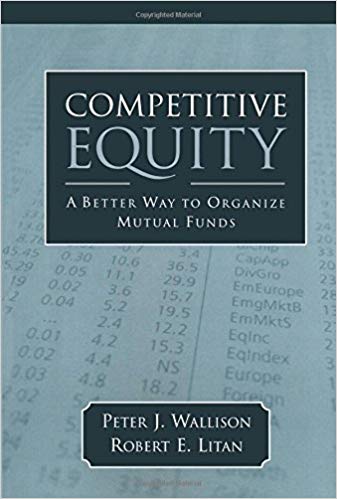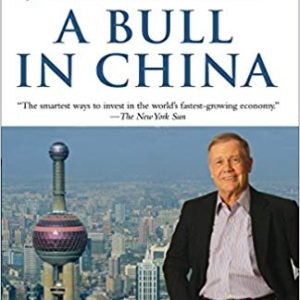Description
Mutual funds have become the investment of choice for millions of Americans, with over $10 trillion in assets currently under management. A significant portion of these assets is used to save for retirement, college and other long-term goals, and small variations in management fees, over time, can substantially reduce the value of investors’ portfolios when they reach retirement age. But, according to a new study, Competitive Equity: A Better Way to Organize Mutual Funds (AEI Press, April 2007), by Peter J. Wallison of the American Enterprise Institute and Robert E. Litan of the Brookings Institution, the current regulatory structure for mutual funds prevents the development of robust price competition among funds and thus keeps investors’ costs higher than they should be.
Most mutual funds today are organized as corporations, with a board of directors ultimately responsible for the operations of the fund, and an investment adviser who manages the fund under a contract. Each fund sells its shares at a price based on the value of its portfolio, and the adviser’s fees and the costs of managing the fund are deducted from the assets of the fund. These fees and costs make up the fund’s “expense ratio” and are approved annually by the fund’s board of directors.
Despite the large number of advisers and funds, the mutual fund industry does not exhibit the convergence in prices that would be expected from a competitive market. For this study, Wallison and Litan examined the expense ratios of 811 ordinary equity funds in the United States and found a disparity in expense ratios of 300 percent between the least expensive and most expensive funds–a disparity that cannot be explained by a difference in product or service and therefore must be attributed to the way mutual funds are regulated, and primarily to the fact that the adviser’s fees and the other expenses of the fund must be approved by the fund’s board of directors.
To demonstrate the effect of board involvement in rate-setting, Wallison and Litan point to the system of collective investment used in the United Kingdom, and to the pricing of separately managed accounts in the United States. (Known as SMAs, these individual investment accounts are offered by financial consultants and managed by independent money managers under an asset-based fee structure.) In the United Kingdom, investment advisers, who are not subject to board approval, set their own fees. In examining the expense ratios of over 450 UK equity funds, the authors found more convergence in pricing, with the highest-cost funds being only about 50 percent more expensive than the least expensive ones. Similarly, in the case of SMAs in the United States, the great proportion of prices fall between three quarters of 1 percent and 1 percent.
In Competitive Equity, Wallison and Litan demonstrate that the huge difference in expense ratios is a result of the “cost-plus” process that boards use to assess the reasonableness of advisers’ profits. The existing system reduces the incentive of advisers to lower either their fees or the expenses of managing the fund–the costs which together make up the expense ratio. The authors find that the rate-setting process used by mutual fund boards bears a strong resemblance to rate-setting by electric utility commissions, which has been shown to reduce the incentive of electric utilities to operate efficiently and reduce costs. Accordingly, Wallison and Litan recommend that the approval of fees and management expenses by boards be eliminated, and that investment advisers be permitted to set their own fees competitively.
By pointing to the rate-setting process as the cause of the huge expense ratio disparity among mutual funds, the authors challenge the long-standing policy of the Securities and Exchange Commission, which believes that the problem with mutual fund pricing stems from a “conflict of interest” between the adviser and the fund’s shareholders, and as a result has sought to increase the proportion of independent directors on fund boards and encourage these boards to press advisers for reduced fees and expenses. Wallison and Litan contend that this effort has been misdirected for forty years, and that it has only made the problem worse.
The authors remind us that in every industry in which rate deregulation has occurred and companies have been allowed to set their rates competitively–including airlines, telecommunications, trucking, and securities brokerage–competition has increased and consumer prices have declined. There is ample reason, they argue, to believe the same would happen in the mutual fund industry once advisers are free to compete on the basis of fees.
To encourage vigorous price competition, Wallison and Litan propose the creation of a new optional legal structure for collective investment, which they call the “managed investment trust” (MIT). In this arrangement, investors would buy units of investment in a trust, held by a bank and managed by an investment adviser. There would be no board of directors. The authors believe that this new organizational form, in which advisers would be permitted to set their own rates for managing a collective investment fund, would drive down costs for investors. Investors who are pleased with their current mutual funds could remain invested there, but they could alternatively choose an MIT with competitively set prices.
Peter J. Wallison is a senior fellow at the American Enterprise Institute, where he is the codirector of AEI’s Financial Services Project on Financial Market Deregulation. Robert E. Litan is vice president for research and policy at the Kauffman Foundation, a senior fellow in the Economic Studies and Global Studies Program at the Brookings Institution, and codirector of the AEI-Brookings Joint Center on Regulatory Studies.





